|
|

Art Vs. Architecture
Museum designers wrestle with an age-old question: Who’s the star—the building or its contents?
By Andrew McClellan, Dean of Academic Affairs, Professor of Art History
If you have any interest in art or urban cultural life, you will have noticed that art museums are hot. In 2002, more than 100 million Americans visited an art museum, a fourfold increase since the early 1960s. New buildings are ubiquitous. The 1990s witnessed what the New
York Times described as “the broadest, grandest, most ambitious museum boom” in history, and the boom continues. Cutting-edge buildings designed by a cadre of globe-trotting architects have energized their host cities. Urban planners now speak of the “Bilbao effect,” referring to the remarkable success of Frank Gehry’s new Guggenheim Museum in northern Spain as an engine of urban renewal, economic expansion, and local pride. In the United States, communities from Denver to Davenport, and Biloxi to Boston, have turned to new museums in the hope of replicating the miracle of Bilbao.
Within the art world, however, there has been much disagreement over what constitutes good museum design. On one side, architects and city officials tend toward showpiece buildings that have drawing power as bold works of art in their own right. On the other side, museum curators and art critics see splashy architecture as an unfortunate distraction from the art on display. As Roberta Smith in the New
York Times put it: “Buildings don’t make museums; art and only art does.”
Though the controversy is very much of the moment, the tension between building and contents is as old as the museum itself. Beginning with the Uffizi in Florence and the Louvre in Paris—both now more than 200 years old—there has always been a desire to represent the idea of the museum as repository of mankind’s greatest achievements through magnificent architecture. And for just as long, art lovers have insisted on the primacy of art and resisted the allure of the building.
As a rule, older museums with great collections favor restrained architecture that allows the art to shine; museums looking to gain a following or to revitalize themselves gravitate to spectacular buildings. In fact, most new museums reach for a compromise. Even Frank Gehry’s museums house neutral galleries, while sedate structures by art-friendly architects such as Renzo Piano are much more than bland boxes. Nevertheless, remarkably few museums have pleased both sides. In recent decades, only the late Louis Kahn, best known for the Kimbell Museum in Fort Worth and his two galleries at Yale, has been universally admired—though the work of Piano and the Japanese architects Tadao Ando and Sanaa (Kazuyo Sejima + Ryue Nishizawa) may one day achieve similar acclaim.
For better or worse, museum architecture is an essential part of the museum experience, and we are fortunate to be living through an era of such tremendous innovation. Next time you visit an art museum, try paying as much attention to the building as you do to the art on exhibition.
 |
 |
 |
 |
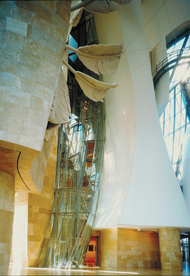
Frank Gehry, Guggenheim Museum, Bilbao, Spain, 1997
Frank Gehry’s Guggenheim Museum in Bilbao, Spain, has been controversial since the day it opened. Described by fans of architecture as perhaps the greatest building of the twentieth century, it has been roundly criticized by art world insiders as extravagant folly that overpowers the art it contains. Nevertheless the museum has been an enormous success. Attendance has greatly exceeded expectations, and the once-forgotten industrial town in northern Spain has sprung back to life. In the decade since it opened, cities around the world have turned to museums in the hope of replicating the Guggenheim’s success as an engine of tourism, urban revitalization, and local pride.
Photographs by Erika Barahona-Ede ©FMGBGuggenheim
Bilbao Museoa, 2005, Guggenheim Museum Bilbao
|
 |
 |
 |
 |

Daniel Libeskind, Denver Art Museum extension, 2006 Cities hoping to emulate the example of Bilbao have embraced dramatic museum buildings to attract visitors, donors, and revenue-raising exhibitions. Denver’s new museum by Daniel Libeskind is a good example of the “Bilbao effect.” Critics insist that buildings alone won’t keep the public coming, and that eye-popping architecture diminishes the collections on which the long-term viability of the museums rests. But, of course, people go to museums for more than the art; they also go to escape the everyday world, to be inspired, and even to shop and socialize—functions that spectacular architecture can enhance.
Photograph by Jeff Wells, courtesy of the Denver Art Museum
|
 |
 |
 |
 |
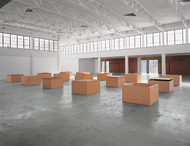
Dia: Beacon, New York, 2003 At the other end of the spectrum from Bilbao, a few collections have rejected extreme architecture by opening in disused industrial buildings deliberately lacking in character and hubris. In such buildings, the art (and curator) reigns supreme. Dia: Beacon, north of New York City, occupies a former Nabisco box factory that was transformed by the artist Robert Irwin and OpenOffice Arts + Architecture Collaborative. When it opened, the museum was hailed by traditional critics as the “anti-Bilbao.” Dia’s austere spaces are in fact well suited to the Minimalist art that makes up the collection (here, Donald Judd’s plywood boxes, photographed circa 2005). With its healthy endowment and select following, Dia has no need, or desire, to attract the masses. If you go—it’s most certainly worth a visit—be sure to dress in black and have a Metro North train schedule sticking out of your back pocket.
Photograph by Bill Jacobson. Donald Judd, untitled, 1976. Dia Art
Foundation; gift of the Brown Foundation
|
 |
 |
 |
 |
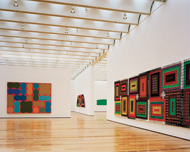
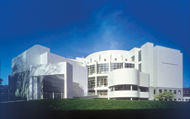
Renzo Piano, High Museum of Art extension, 2005 Richard
Meier, High Museum of Art, Atlanta, 1983 Atlanta’s High Museum is an interesting example of conflicting trends in museum design. In the early 1980s, the city turned to Richard Meier, known for his sleek and alluring white buildings, to put its museum on the map (bottom right). In the beginning, the building was more of a draw than the fledgling collection. Twenty years later, the museum needed an extension (top right) to house its growing inventory and to announce a new seriousness of purpose. Renzo Piano, internationally renowned for his elegant and art-friendly museums and additions, was given the commission. When asked why the museum hadn’t asked Meier to add on to his own building, the director replied: “Meier has a tendency to make spectacular buildings. We already had a statement building.”
Photographs by Jonathan Hillyer (High Museum of Art extension);
courtesy of the High Museum of Art.
|
 |
 |
 |
 |
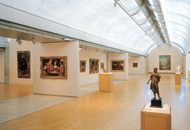 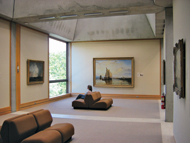
Louis Kahn, Kimbell Art Museum, Fort Worth, Texas,
1972 Louis Kahn, Yale Center for British Art,
New Haven, Connecticut, 1977 Everyone loves Louis Kahn’s buildings. A combination of stately but restrained exteriors, beautiful light, an intuitive use of materials, and serene, domestically scaled galleries makes Kahn’s art museums ideal viewing environments. Kahn designed only three museums—the Kimbell in Fort Worth (top right), the recently restored Yale Art Gallery (1953), and the Yale Center for British Art (bottom right) across the street. Since his death in 1974, Kahn has achieved cult status among architects, critics, and museum curators.
Photographs by Steven Watson
© 2004 Kimbell Art Museum (Kimbell Art Museum); Andrew McClellan (Yale Center)
|
 |
 |
 |
 |
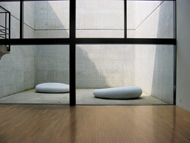 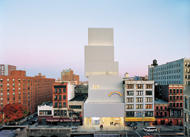
Tadao Ando, Museum of Contemporary Art, Naoshima, Japan, 1992
Sanaa, New Museum of Contemporary Art, New York,
2007 Alongside Renzo Piano, a few Japanese have been gaining momentum as go-to architects for those keen to avoid the Bilbao effect. Tadao Ando established his reputation with a number of refined museums in his native Japan, notably his contemporary art museum on the remote island of Naoshima (top right). Influenced by Louis Kahn, Ando makes simplicity of space, materials, and light the trademarks of his buildings. Two new architects on the world scene are the partnership of Sanaa (Kazuyo Sejima + Ryue Nishizawa), whose new contemporary art museum on the Bowery in New York (bottom right) opened to rave reviews in December 2007.
Photographs by Andrew McClellan (Naoshima); Dean Kaufman (New York)
ANDREW McCLELLAN is dean of
academic affairs in Tufts’ School of Arts & Sciences and a professor
of art history, specializing in the history and theory of museums. His
latest book is The Art Museum from Boullée to Bilbao (University
of California Press). |
|
|










